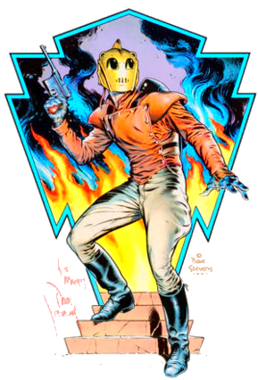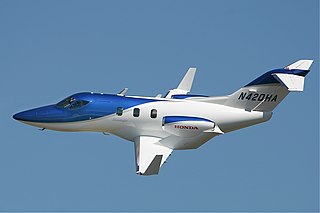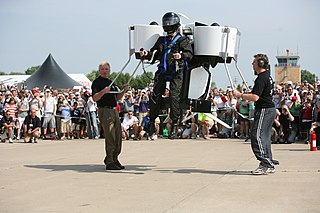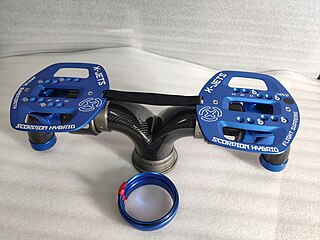Related Research Articles

Ultralight aviation is the flying of lightweight, 1- or 2-seat fixed-wing aircraft. Some countries differentiate between weight-shift control and conventional three-axis control aircraft with ailerons, elevator and rudder, calling the former "microlight" and the latter "ultralight".

The Rocketeer is a comic book superhero, created by writer/artist Dave Stevens. The character first appeared in 1982 and is an homage to the Saturday matinee serial heroes from the 1930s through the 1950s.

A hoverboard is a fictional levitating board used for personal transportation, first described in science-fiction, and made famous by the appearance of a skateboard-like hoverboard in the film Back to the Future Part II. Many attempts have been made to invent a functioning hoverboard.

A jet pack, rocket belt, rocket pack or flight pack is a device worn as a backpack which uses jets to propel the wearer through the air. The concept has been present in science fiction for almost a century and the first working experimental devices were demonstrated in the 1960s.

A flight recorder is an electronic recording device placed in an aircraft for the purpose of facilitating the investigation of aviation accidents and incidents. The device may often be referred to colloquially as a "black box", an outdated name which has become a misnomer—they are now required to be painted bright orange, to aid in their recovery after accidents.

The Honda HA-420 HondaJet is a light business jet produced by the Honda Aircraft Company of Greensboro, North Carolina, United States. Original concepts of the aircraft started in 1997 and were completed in 1999. It took its maiden flight on December 3, 2003, received its FAA type certificate in December 2015, and was first delivered that same month. By the end of 2021, 200 jets had been delivered.
ExpressJet Airlines was a regional airline in the United States that operated from 1987 until 2022. It was headquartered in College Park, Georgia. The company began as Britt Airways and flew exclusively as Continental Express, the contracted codeshare partner for Continental Airlines. The name was changed to ExpressJet at the beginning of 1995 as the company began acquiring regional jets, replacing its fleet of turboprop aircraft. Along with flying as Continental Express, ExpressJet expanded flying under the Delta Connection brand from 2007 through 2008 and again from 2012 through 2018. Service as American Eagle was flown between 2012 and 2019 and service under the United Express brand began in 2009. ExpressJet also flew an independent operation under their own brand in 2007 through 2008. When Continental Airlines merged into United Airlines in 2012, the Continental Express operations were added to the United Express service. In September 2020, it exited the fee-for-departure airline market and temporarily ceased flights after the conclusion of its contract with its sole remaining mainline partner, United Airlines. In September 2021, ExpressJet resumed operations as both an air charter provider and a regional airline under its own brand aha!—short for "Air-Hotel-Adventure." The brand's route structure focused on the West Coast of the United States with a hub at Reno-Tahoe International Airport, and scheduled flights began on October 24, 2021. The airline, including its brand aha!, filed for bankruptcy on August 23, 2022, having ceased all operations the previous day. In July 2023, the airline announced plans to relaunch as an air charter service using a single leased Boeing 777.

The SoloTrek XFV was a single-person VTOL aircraft. It was first flown in December 2001 by Millennium Jet Inc, a private company run by Michael Moshier. Millennium Jet subsequently changed its name to Trek Aerospace Inc. The SoloTrek pilot maintained a standing position and was propelled by two ducted fans located above and on either side of the user, leading some to class it as a type of backpack helicopter. It ran for around 2 hours on gasoline fuel. According to Michael Moshier, its inventor and designer, SoloTrek was capable of hovering for up to two hours, flying at 100 km/h and travelling more than 200 km.

A backpack helicopter is a helicopter motor and rotor and controls assembly that can be strapped to a person's back, so they can walk about on the ground wearing it, and can use it to fly. It uses a harness like a parachute harness and should have a strap between the legs. Some designs may use a ducted fan design to increase upward thrust. Several inventors have tried to make backpack helicopters, with mixed results.

Yves Rossy is a Swiss military-trained pilot and an aviation enthusiast. He is known as the inventor of a series of experimental individual jet packs, the latest using carbon-fiber wings for flight. Often referred to as "Jetman", Rossy has sometimes tested and presented new versions of his jetpacks in high-profile events staged around the world.

The Martin Jetpack was a single-person aircraft under development. Despite its name, it did not use a jet pack as such, but ducted fans for lift. Martin Aircraft Company of New Zealand developed it, and unveiled it at the Experimental Aircraft Association's 2008 AirVenture in Oshkosh, Wisconsin, US. The US Federal Aviation Administration classified it as an experimental ultralight airplane.
Troy Hartman is a professional aerial stuntman, skydiver and inventor. He is an X Games gold medalist for skysurfing and accomplished television host for many shows, most notably the MTV series Senseless Acts of Video. He was the face of the award-winning 1998 Pepsi Super Bowl commercial.

A Flyboard is a brand of hydroflighting device which supplies propulsion to drive the Flyboard into the air to perform a sport known as hydroflying.

Hydroflight sports are a category of sport in which water jet propulsion is used to create sustained flight where lift and movement are controlled by a person riding on a propulsion device. Competitions for this sport started around 2012. There are many training centres throughout the world where beginners go to learn and practice skills so they can fly these devices by themselves.
AMT Nike is a small turbojet, used to power model, homebuilt aircraft and some jetpacks.

Flyboard Air is a type of jetpack/hoverboard powered by gas turbines. It was invented by French water-craft rider Franky Zapata, founder of Zapata racing.

The JetLev is a water-propelled jet pack powered through a floater derived from jetski technology attached through an umbilical to the backpack which contains two nozzles and two control arms, in a configuration like traditional rocket belts and gas turbine jet belts. The JetLev also functions underwater, allowing users to dive into the water and jet back out. The jetpack can allow users to fly up to 10 m above the water. It was created by Chinese Canadian, Raymond Li. JetLev became the first practical amateur-usable jet pack, and first with practical usable duration. The JetLev technology jetpack became the first commercially released jetpack in 2009. It was initially offered for sale for US$100,000, however with much cheaper competitors coming on the market afterwards, inspired by the original JetLev, such as the Flyboard, prices rapidly dropped, with cheaper models.

Franky Zapata is a French personal watercraft pilot who is the inventor of the Flyboard and Flyboard Air, and founder of Zapata Racing. Since 2012, Zapata's efforts have been focused on the development and manufacture of personal flyers for land and aquatic applications.
An electric vertical take-off and landing (eVTOL) aircraft is a variety of VTOL aircraft that uses electric power to hover, take off, and land vertically. This technology came about thanks to major advances in electric propulsion and the emerging need for new aerial vehicles for urban air mobility that can enable greener and quieter flights. Electric and hybrid propulsion systems (EHPS) have also the potential of lowering the operating costs of aircraft.
Jetpack man, also described as guy in a jetpack or Iron Man, is an unknown person or object that has been observed flying what appears to be an unauthorized jetpack around the Los Angeles area at least five times from 2020 to 2022. Multiple airplane pilots have reported seeing the jetpack man at altitudes around 5,000 feet (1,500 m).
References
- 1 2 Blain, Loz (November 9, 2015). "JB-9 jetpack makes spectacular debut flying around Statue of Liberty". New Atlas. Archived from the original on May 27, 2023. Retrieved August 18, 2023.
- ↑ Blain (September 8, 2021). "JetPack Aviation makes first jetpack sales to unnamed military". New Atlas. Archived from the original on June 5, 2023. Retrieved August 18, 2023.
- ↑ Hood, Lonnie Lee (May 6, 2022). "Inventor Says He's Built a Real Life Flying Motorcycle". Futurism. Archived from the original on June 3, 2023. Retrieved August 18, 2023.